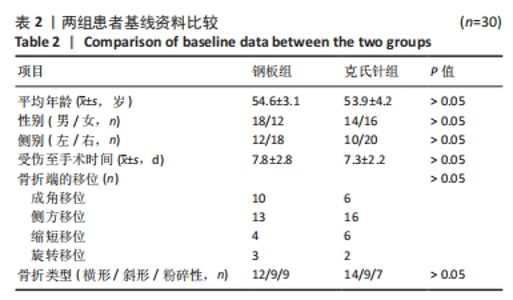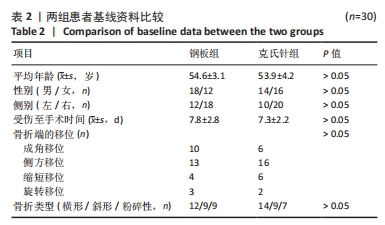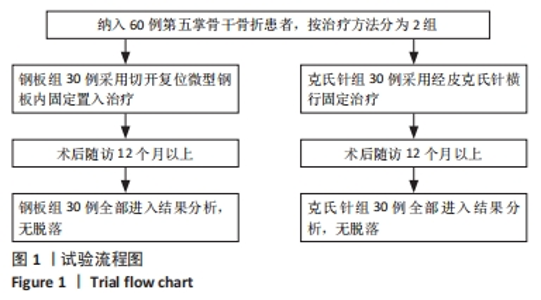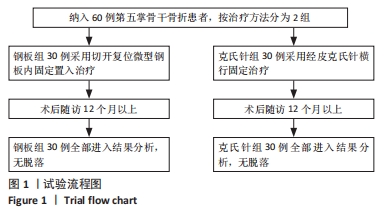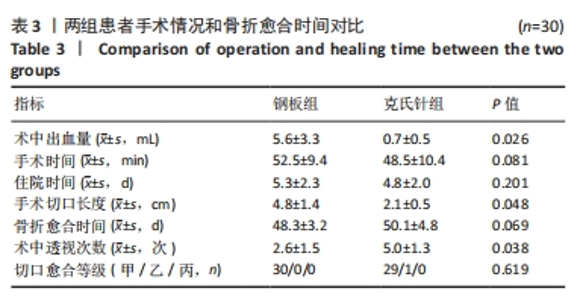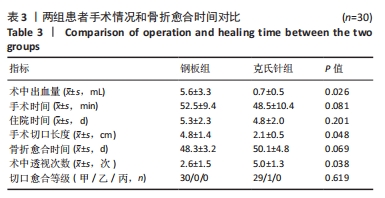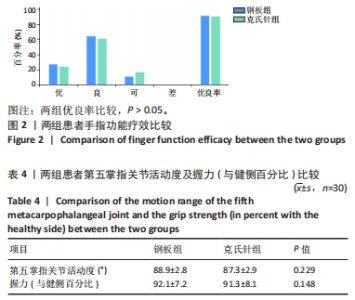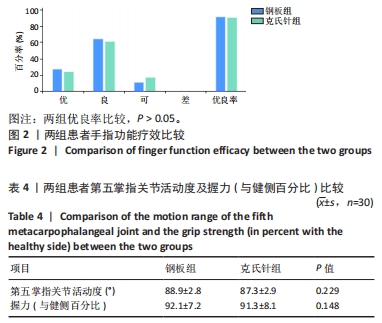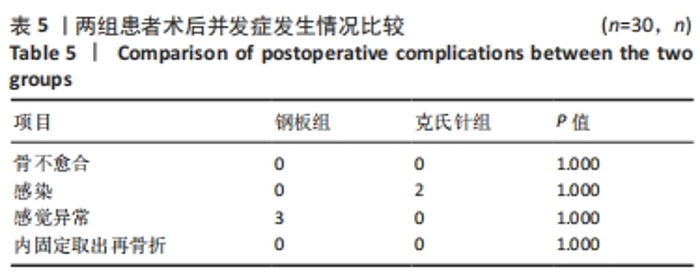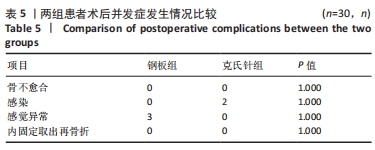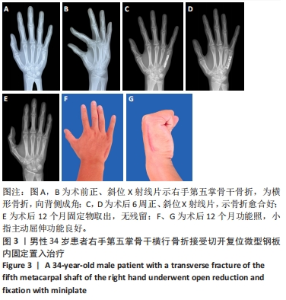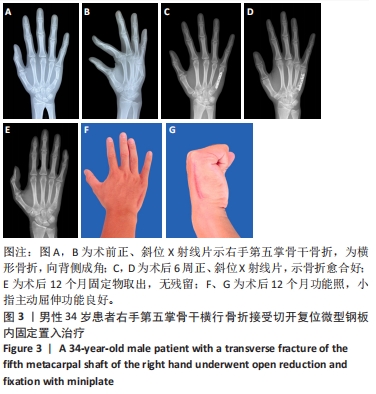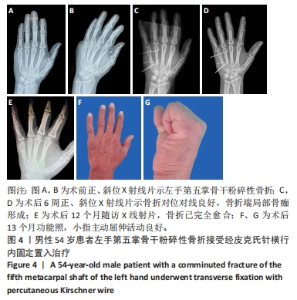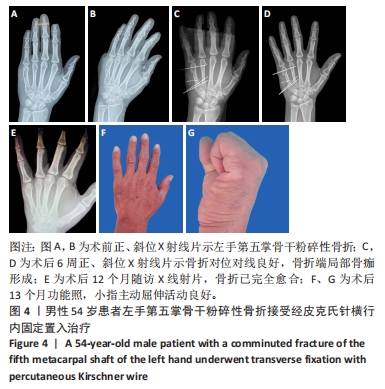[1] ZHANG JF, LI Y, HUO YX, et al. Biomechanical analysis of locking plates for fixation of metacarpal shaft fractures:A finite element analysis.Orthop Traumatol Surg Res. 2022;108(8):103340.
[2] NELSON BA, TRENTADUE TP, SOMASUNDARAM V, et al. A Comparison of Outcomes following Plate versus Pin Fixation of Metacarpal Shaft and Neck Fractures. Plast Reconstr Surg Glob Open. 2023;11(1):e4741.
[3] CHIU YC, HO TY, HSUCE, et al. Comparison of the fixation ability between lag screw and bone plate for oblique metcarpal shaft fracture. J Orthop Surg Res. 2022;17(1):1-6.
[4] HUTCHISON RL, BOLES J, DUAN Y. Biomechanical Modeling of Connecting Intermetacarpal K-Wires in the Treatment of Metacarpal Shaft Fractures. Hand (N Y). 2022;17(3):412-415.
[5] LAZARUS P, HIDALGO DIAZ JJ, XAXIER F, et al. Transverse and oblique fractures of the diaphysis of the fifth metacarpal:surgical outcomes for antegrade intramedullary pinning versus combined antegrade and retrograde intramedullary pinning. Eur J Orthop Surg Traumatol. 2020;30(3):425-433.
[6] LV F, NIE Q, GUO J, et al. Comparative analysis of the effects of AO mini-plate and Kirschner wire pinning in the metacarpal fractures:A retrospective study. Medicine(Baltimore). 2021;100(26):e26566.
[7] BERKMAN EF, MILES GH. Internal fixation of metacarpal fractures exclusive of the thumb. J Bone Joint Surg Am. 1943.
[8] 明立功, 明朝戈, 王自方, 等.经皮克氏针横行平行或交叉支撑固定治疗第五掌骨颈骨折[J].中国修复重建外科杂志,2020,34(2): 272-274.
[9] AKINLEYE SD, GAROFOLO-GONZALEZ G, CULLBERTSON MD, et al. Injuries in Percutaneous Pinning Techniques for Fifth Metacarpal Neck Fractures. Hand(N Y). 2019;14(3):386-392.
[10] 潘达德, 顾玉东, 侍德, 等.中华医学会手外科学会上肢部分功能评定试用标准[J].中华手外科杂志,2000,16(3):130-135.
[11] BUCKLEY RE, MORAN CG, APIVATTHAKAKUL T. 骨折治疗的AO原则[M].3版.上海:上海科学技术出版社,2019:677.
[12] EISENSCHENK A, SPITZMÜLLER R, GÜTHOFF C, et al. Single versus dual Kirschner wires for closed reduction and intramedullary nailing of displaced fractures of the fifth metacarpal neck (1-2 KiWi): a randomized controlled trial. Bone Joint J. 2019;101-B(10):1263-1271.
[13] 顾玉东.如何治疗手部骨折-评AO微型钢板的应用价值[J].中华手外科杂志,2002,18(2):65.
[14] GUIDI M, FRUEH FS, BESMENS I, et al. Intramedullary compression screw fixation of metacarpal and phalangeal fractures. EFORT Open Rev. 2020;5(10):624-629.
[15] 马创,杜亮,袁继忠,等.Orthofix微型外固定架治疗掌骨开放性骨折疗效分析[J].中华手外科杂志,2018,34(2):93-96.
[16] 林岩生,张启明,陈远华,等.Nice结联合外固定治疗掌骨干不稳定型骨折的疗效分析[J].福建医药杂志,2022,44(6):100-103.
[17] KATAYAMA T, FURUTA K, ONO H, et al. Clinical outcomes of unstable metacarpal and phalangeal fractures treated with a locking plate system:a prospective study. J Hand Surg Eur. 2020;45(6):582-587.
[18] WINTER M, BALAGUER T, BESSIÈRE C, et al. Surgical treatment of the boxer’s fracture: transverse pinning versus intramedullary pinning.J Hand Surg Eur. 2007;32(6):709-713.
[19] 靳安民,汪华侨.骨科临床解剖学[M].济南:山东科学技术出版社, 2010:159-160.
[20] VAN BUSSEL EM, HOUWERT RM, KOOTSTRA TJM, et al.Antegrade intramedullary Kirschner-wire fixation of displaced metacarpal shaft fractures.Eur J Trauma Emerg Surg. 2019;45(1):65-71.
[21] SLETTEN IN, NORDSLETTEN L, HUSBY T, et al. Isolated, extra-articular neck and shaft fractures of the 4th and 5th metacarpals: a comparison of transverse and bouquet (intra-medullary) pinning in 67 patients.J Hand Surg Eur. 2012;37(5):387-395.
[22] 李文锋,侯树勋,张伟佳.碘伏与酒精对外固定器术后钉道消毒效果比较的临床研究[J].中华外科杂志,2006,44(16):1150-1151.
[23] 丰瑞兵,王华松,胡昊,等.钢板与克氏针固定Bennett骨折的比较[J].中国矫形外科杂志,2023,31(4):305-309.
[24] CHIU YC, HO TY, TING YN, et al. Effect of oblique headless compression screw fixation for metacarpal shaft fracture:a biomechanical in vitro study. BMC Musculoskelet Disord. 2021;22(1):1-9.
[25] 朱海泉.第二掌骨, 食指近中节指骨骨折的有限元分析[D].南京:南京医科大学,2018.
[26] 汤锦波.手外科经典方法与现代技术[M].上海:上海科学技术出版社,2022:79.
[27] KEVIN C.CHUNG. OPERATIVE TECHNIQUES: HAND AND WRIST SURGERY[M].陈山林, 译.北京:北京大学医学出版社,2021:100.
[28] LALONDE DH. Latest Advances in Wide Awake Hand Surgery. Hand Clin. 2019;35(1):1-6.
[29] HYATT BT, RHEE PC. Wide-Awake Surgical Management of Hand Fractures:Technical Pearls and Advanced Rehabilitation. Plast Reconstr Surg. 2019;143(3):800-810.
[30] 庞波涛, 宋坤修, 郭洋, 等.闭合复位单根顺行髓内针内固定治疗第五掌骨颈骨折[J].中华手外科杂志,2021,37(5):383-384.
[31] 李大为, 姜德欣, 蒋明, 等.闭合复位穿针邻掌骨间接固定治疗新鲜闭合单一掌骨骨折[J].中华手外科杂志,2017,33(6):474-475.
[32] HIATT SV, BEGONIA MT, THIAGARAJAN G, et al. Biomechanical Comparison of 2 Methods of Intramedullary K-Wire Fixation of Transverse Metacarpal Shaft Fractures. J Hand Surg Am. 2015;40(8): 1586-1590.
[33] 王洪宾, 曾文超, 刘淑永, 等.横向克氏针固定治疗老年粉碎性掌骨骨折[J].实用骨科杂志,2015,21(6):571-572.
[34] 明立功, 明立山, 王自方, 等.闭合复位经皮克氏针横行支撑固定治疗新鲜掌骨多发骨折[J].中华手外科杂志,2017,33(1):12-13.
[35] 张文龙, 高顺红, 陈超, 等.闭合复位克氏针横行固定治疗掌骨颈骨折[J].中华手外科杂志,2011,27(4):247-249. |
